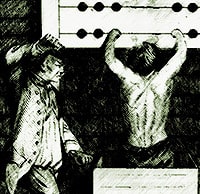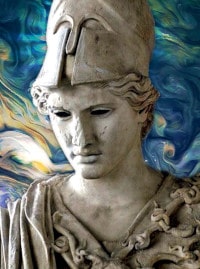The Requirement
The real downer about switching from writing history and self-help to writing science-fiction is the realization that your research has just begun. In some ways your research requirement for fiction is more comprehensive than many nonfiction works. Fortunately I like research. But still, for a writer who is trying to make up for taking off for the 20 years that should have been his prime, fact-checking can began to feel like an inner mother-in-law, the impulse that never lets go and breaks your rhythm while your banging out a combat scene, or are in the groove of a fluid dialogue. She is necessary though, so, just like that nagging mother-in-law, who does have her useful qualities, I like to make the research that turned out to be ‘defensive’ [like making sure you don’t put the wrong plant on the wrong continent] work toward enriching not only the setting, but the narrative.
A good deal of speculative fiction and nonfiction has been written on pre-modern European humans. Always being fascinated with the subject I could not resist dedicating one of the ‘genetic reclamation’ time travel missions in my Sunset Saga to grabbing a Neanderthal kid. Asimov and Silverberg beat me to it so I felt compelled to go one better. Writing any SF novel outside of straight fantasy takes much more research than the reader generally realizes. And, as with all research you learn much more than your outline will likely accommodate. I address that in the next section.
First, I had to make sure I based my plot around known factors such as geography, climate, vegetation, animal life and technology. Time travel is crazy enough. I can’t go and suppose that horsemanship was learned 35,000 years ago like the Clan of the Cave Bear author did. To make the time travel believable and even meaningful I have to base the plot as much on known factors as possible.
It is quite bad enough that I was going to have to present a Neanderthal culture based on the slim evidence left us. For instance, I had to jettison such ideas as ‘man’ and ‘woman’, and even ‘male’ and ‘female’ and got as bare bones as I could and went with ‘he’ and ‘she’. An editor would bust my balls for taking the language closer to a primal definition and possibly straying from the modern perspective and losing readers. Well I have time travelers to supply the modern perspective. My Neanderthals need to be chronological aliens at least, and to a large extent, genetic aliens.
The Ancillary Sludge
Wild life quirks, unexpected climatic factors, anything I did not expect to find before beginning the research—in other words the good stuff—was used to expand the novella length outline to novel form. I did not divert the narrative arc but inserted subplots as bookmarks within chapters.
You might say this is letting the setting take over, another no-no in popular writing. Again, since this is fact-based and coming after the outline, and the fact that the characters are kept—by my cruel god’s hand—committed to the narrative, the environment itself becomes the enemy, supplies the plot twists that would be provided by bogus serendipity and Grimer Wormtongue type characters. Once I realized this was happening I started to get more of a sense that the habitat of Ice Age Europe, which is currently much better understood than it was when I did my initial reading in the 1980s, was becoming the villain, obviating the need for Darth Vader homo sapiens coming up from the warm lands to wreak WWII levels of havoc.
Letting the Characters Shape the Narrative
Writing a character rotation with four extreme viewpoints can be demanding. You don’t want your crack dealer speaking like your physicist—which is common dialogue practice with comic writers. To setup clear perspective shifts I developed the table of contents, including bookmarks, with each chapter and bookmark titled according to wording appropriate to that character, how he would have described the experience. If you examine the list of protagonists below and match them with the chapters and subservient bookmarks, you should be able to guess the viewpoint from which each chapter is written without reading anything other than the dust cover, protagonists, and contents.
Those are the three elements that this novel was built from. The writing of each chapter is a triangulation of the incomplete summary represented by the dust cover, the narrative arc embodied in the contents, and the protagonists who have been pushed by the summary into the narrative, and who would dearly like to be around for a sequel.
For a writer who is having a hard time structuring their novel and/or peopling it with protagonists I suggest trying this as a mental exercise. And do not forget to make some of the bookmarks and chapter titles intentionally deceptive. It helps the reader enjoy the plot twists more, and helps you get into the character more intensely when you find yourself writing from behind a person who finds themselves literally out of context.
Dust Cover
A team of four “time-jumpers” is being deployed 35,000 years into the past, tasked with a dual mission: to retrieve a Neanderthal child from Ice Age Europe, and to splinter Time itself. The four man team is being deployed with a device that will generate an alternate timeline if they manage to alter the course of pre-history; by somehow saving the Neanderthals from total extinction. The leader of this team was specifically engineered for this task. His handlers regard him and his three men as utterly expendable.
Ugly Sister is the only daughter of The Family’s dominant she. As the cold-time lingers longer than usual and fear of the Others dampens their hopes she comes to maturity. On the very night that she confronts Mother about her suitability to mate a great ember of a star bursts in the sky. Taking her adult name from this singular event Dawn Star sets off with The Family on a journey that will take them to the very mouth of the Water Dread. Will her vision save them or will they perish at the hands of the ever-encroaching Others?
Protagonists in order of Appearance
1. Charles Carver Robinson, Quantum Physicist
2. Jay Brant Bracken, time-hunter
3. Thomas “Squirt” Edison, time-traveler
4. Ugly Sister, Daughter of the AllMother
Contents
Seekers of The Sunset World 3
Seven Sunset Saga Story Threads by Protagonist 3
Protagonists in order of Appearance 15
Prologue: Inception: 15
Please Get Me Out of This Place 15
Monday Night Lights 22
Doctors for Children 28
The Devil’s Own Crew 30
Pillagers of Time 43
Debriefing Notes 49
Chapter 1: Mrs. White Feather 50
Amble Mesa 52
The Dewey Beach Letter 57
A Grain of Sand 60
Chapter 2: Let It Ride 62
Chapter 3: Player 66
Chapter 4: Zoom! 71
The Boat to Everywhere 71
Three-Rivers 74
Zero Hour 77
Zoom! 79
Chapter 5: Star Fall 84
Mother 84
AllMother 86
Night Face 89
Star Fall 92
Chapter 6: True Brothers 95
An Empty Land 95
On Time 98
Chapter 7: Eaten Alive! 102
Unseen 102
The Tree 105
Laughter at Dusk 107
Eaten 110
Doctor Eddie and Mister Hide 113
Eyes 117
Chapter 8: Star Call 120
The Outward Journey 120
Her Camp 122
Star Call 125
The Snorter 128
Chapter 9: Slather 131
Like a Mad Dog 133
Chapter 10: Let Me Die! 134
Jay-Bone Down 134
Slim Jims 135
Uncle Eddie 139
Mister Hide on Heroin 142
Chapter 11: Star Smile 146
The Other Fire 146
Star Smile 148
Star Meat and Howlers 151
Pounce and Star Smile 154
Chapter 12: Meat! 159
What You Get for Thinking 161
Chapter 13: Smelly People 166
There Goes the Neighborhood 166
Crack-Head 169
Cave-Girl 171
Big Mama 173
Thag 175
Chapter 14: Star Song 178
With The Eddie 178
Sleeper Valley 180
Playing with the Eddie 183
The Eddie Sings 187
Chapter 15: Girl! 190
The Engagement 193
The Wedding 196
Chapter 16: The Hills Alive 202
Tiny Horses 202
Kicking Back 204
Run Son, Run! 208
Chapter 17: Other Fall Dawn 211
Others at Dawn! 211
The Other Song 213
When Death Birds Fly 215
Under the Eyes of the Death-Eddie 219
Other-She 221
Chapter 18: Point of the Spear 224
Under an Uncaring Sky 228
The Fatal Stretch 232
Chapter 19: Star Beast 237
Flowers 237
Star Beast 240
To the Cousin Hills 242
Mother’s Song 244
To the Far Hills 248
The Far Cousins 250
Chapter 20: Fast Food 253
Hunting Hairy Trucks 253
Thanksgiving without a Fork 256
Meet the In-Laws 259
Chapter 21: Other More Come 264
Other Song 264
Way of the Most-mighty-hes 265
Pretty Hair 267
Chapter 22: Skin and Bone 271
Rush Hour 271
The Tent Factory 272
Wake up Son 274
Chapter 23: Tripping 276
Eddie’s Big Idea 276
Big Chickens 278
Johnny Hardtack 285
Ezekiel 289
Miss Astoria 293
The Mind Engine 298
Chapter 24: Davis 302
Chapter 25: Leaves Upon the Water Dread 312
Eddie-Things 312
Upon the Water Dread 315
The New Place 319
Baby-Sick-Cousin 320
Chapter 26: Big Bear Land 323
Cherry Hill 328
Chapter 27: Star Stepping 332
Baby-Bump-Day 332
Upon the Ember Star 334
Chapter 28: In a Blaze of Stupidity 338
What’chyou Lookin’ at Fool? 338
That Booty Too Cutie 343
Vroom! 350
Chapter 29: Wind Walking 353
Mother of the Vroom Eddie’s 353
Vroom Eddie, Vroom! 359
The Perspective Shift Dilemma
Other authors ask me to check the balance on their perspective shifts, I think, because I write fiction with a minimum of undeclared perspective shifts, and the craft and reader expectations based on being exposed to more movie narratives than literary ones, seduces the novelist into using perspective shifts at or near the rate employed by screenwriters. I suppose, as a model of ‘perspective shift austerity’, I have been asked for advice on that which I eschew in the same vein as a tempted man would consult a priest on the dangers of promiscuity, not so much out of a desire to adopt that ethic, but in hopes of achieving the balance necessary for the middle road.
The declared shift is the method I prefer for reader immersion. It is not however preferred by editors or writers with an eye on film adaptation.
The shortcut shift or plot twist, such as the scene in which the hero in Louis L’Amour’s Last of the Breed is suddenly being viewed [from a better camera angle?] by a character that was created and inserted to provide the view, is preferred for novels with an eye on screen adaptation. I prefer realism. So while I enjoy reading such yarns heavy with plot twists, I refrain from using this narrative tool for fear of invoking reader disbelief, which is so important to suspend in a fantasy or sci-fi setting. Some writers I know who employ this method ask me to check for overuse, knowing that they work upon a slim realism margin, and want to maintain the suspension of disbelief they have maintained thus far.
The Game Changer
My commitment to realism in the writing of Beyond the Ember Star brought me to the unalterable conclusion that I was dealing with a primal horror story. In retrospect I think my writing of the chapter Eaten Alive!, in which the team of time travelers is literally torn apart by a pack of giant hyenas, set me on my path to writing horror. I will address that in my upcoming article The Roots of Horror: Why We Are Wired for Fear.
Beyond the Ember Star should be on sale through Amazon by mid August as I am editing it now. It is currently available as one third of our omnibus ebook Pillagers of Time.











